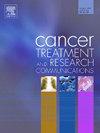2017年至2020年印度尼西亚乳腺癌趋势:按年龄和疾病严重程度进行的国家级分析
IF 2.4
Q3 Medicine
引用次数: 0
摘要
简介:乳腺癌是癌症相关残疾调整生命年(DALYs)的主要原因,也是亚洲妇女(包括印度尼西亚)第二大常见癌症。其日益增加的负担需要对流行病学趋势和经济影响进行全面评估。本研究调查了2017年至2020年印度尼西亚年龄和严重程度特定的乳腺癌发病率、DALYs、医疗保健利用和经济负担模式。方法:采用印度尼西亚卫生和社会保障局(BPJS Kesehatan) 2017-2020年国民健康保险样本数据(NHISD)进行回顾性观察研究。使用ICD-10代码C50识别乳腺癌病例。每年按年龄和疾病严重程度计算发病率、DALYs、医疗资源使用和经济负担。数据处理采用R软件4.2.3版本。结果:发病率、死亡率和DALYs随着年龄的增长而增加,尤其是从35岁开始,在55-59岁达到峰值,其中45-60岁患者的DALYs最高。35-39岁和55-59岁的死亡率和DALY高峰出现在2020年。50-54岁女性的经济负担显著增加,从2017年的600万美元增加到2019年的1300万美元。年龄在35-39岁之间的患者每年的人均费用最高(1410- 1770美元)。门诊费用占主导地位(1700万- 2300万美元),最严重病例的人均费用为1150- 1670美元。结论:尽管发病率略有下降,死亡率相对稳定,但DALYs在2020年达到峰值,凸显了疾病负担的增加。这些趋势强调需要有针对性的医疗资源分配和缓解策略,特别是对35-39岁、45-60岁和门诊服务的人群。本文章由计算机程序翻译,如有差异,请以英文原文为准。
Trends in breast cancer in Indonesia from 2017 to 2020: A national-level analysis by age and disease severity
Introduction
Breast cancer is a leading cause of cancer-related disability-adjusted life years (DALYs) and the second most common cancer among Asian women, including in Indonesia. Its increasing burden necessitates a comprehensive assessment of epidemiological trends and economic impact. This study examines age- and severity-specific patterns of breast cancer incidence, DALYs, healthcare utilization, and economic burden in Indonesia from 2017 to 2020.
Methods
A retrospective observational study was conducted using 2017–2020 National Health Insurance Sample Data (NHISD) from Indonesia’s Health and Social Security Agency (BPJS Kesehatan). Breast cancer cases were identified using ICD-10 code C50. Incidence, DALYs, healthcare resource use, and economic burden were calculated annually by age and disease severity. Data were processed using R software version 4.2.3.
Results
Incidence, mortality, and DALYs increased with age, particularly from age 35, peaking at 55–59 years, with DALYs highest among patients aged 45–60. Mortality and DALY peaks were observed in 2020 for ages 35–39 and 55–59. The economic burden rose significantly for women aged 50–54, from US$6 million in 2017 to US$13 million in 2019. Patients aged 35–39 incurred the highest annual per-patient costs (US$1410–US$1770). Outpatient costs dominated (US$17 million–US$23 million), with the most severe cases incurring per-patient costs of US$1150–US$1670.
Conclusion
Despite a slight decline in incidence and relatively stable mortality, DALYs peaked in 2020, highlighting an increasing burden of disease. These trends underscore the need for targeted healthcare resource allocation and mitigation strategies, particularly for those aged 35–39, 45–60, and outpatient services.
求助全文
通过发布文献求助,成功后即可免费获取论文全文。
去求助
来源期刊

Cancer treatment and research communications
Medicine-Oncology
CiteScore
4.30
自引率
0.00%
发文量
148
审稿时长
56 days
期刊介绍:
Cancer Treatment and Research Communications is an international peer-reviewed publication dedicated to providing comprehensive basic, translational, and clinical oncology research. The journal is devoted to articles on detection, diagnosis, prevention, policy, and treatment of cancer and provides a global forum for the nurturing and development of future generations of oncology scientists. Cancer Treatment and Research Communications publishes comprehensive reviews and original studies describing various aspects of basic through clinical research of all tumor types. The journal also accepts clinical studies in oncology, with an emphasis on prospective early phase clinical trials. Specific areas of interest include basic, translational, and clinical research and mechanistic approaches; cancer biology; molecular carcinogenesis; genetics and genomics; stem cell and developmental biology; immunology; molecular and cellular oncology; systems biology; drug sensitivity and resistance; gene and antisense therapy; pathology, markers, and prognostic indicators; chemoprevention strategies; multimodality therapy; cancer policy; and integration of various approaches. Our mission is to be the premier source of relevant information through promoting excellence in research and facilitating the timely translation of that science to health care and clinical practice.
 求助内容:
求助内容: 应助结果提醒方式:
应助结果提醒方式:


